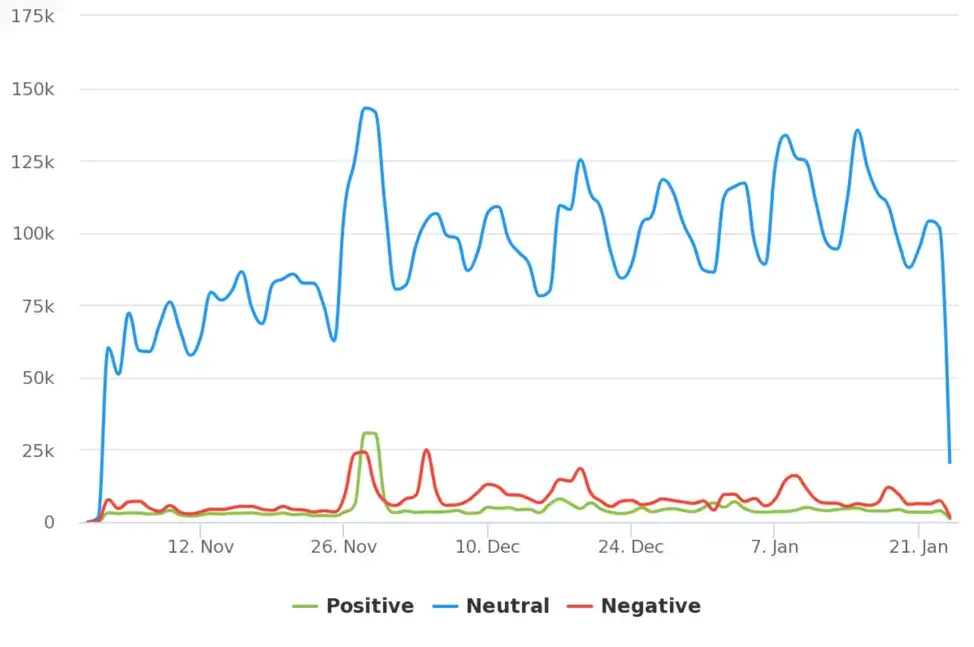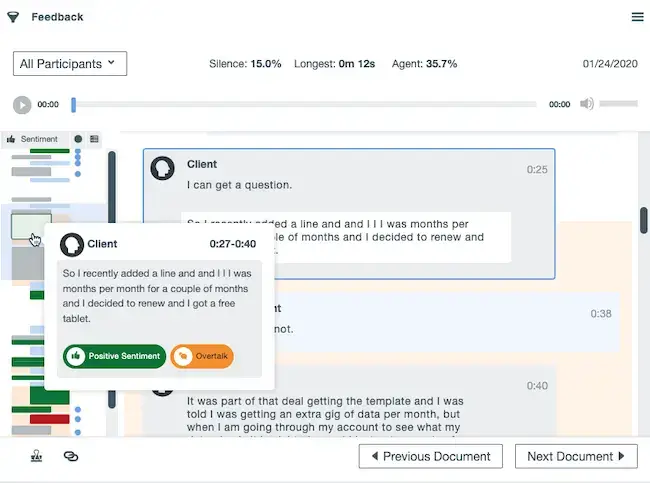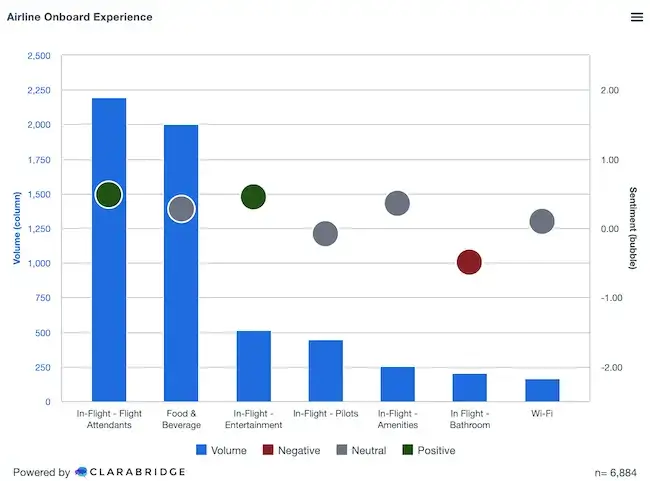What is sentiment analysis?
Sentiment analysis is the process of identifying and interpreting emotional tone in qualitative data, to ultimately understand how a person or audience feels about a specific topic, product, service or experience.
Often confused with text analysis, sentiment analysis determines whether the attitude or opinion of a review, social media post or survey response is positive, negative or neutral — converting qualitative data into quantifiable metrics.

If you’ve ever done any of those things — left an online review, made a comment about a brand or product online, answered a market research survey — there’s a chance your responses have been through sentiment analysis.
For customer experience managers, market researchers and marketers, sentiment analysis is a powerful, evolving way to unlock a deeper layer of insight — going beyond what people say to uncover how they feel.
It enables businesses to sift through vast amounts of qualitative data at scale, highlight emerging issues or opportunities, and make data-informed decisions that can improve experiences and brand perception.
Learn how Qualtrics® XM can help you conduct sentiment analysis
Sentiment analysis vs. semantic analysis
Two similar but ultimately different — albeit easily confused — disciplines.
Sentiment analysis classifies the emotional tone of a message — positive, negative or neutral. Semantic analysis, on the other hand, interprets the meaning of words and phrases in context. It looks at relationships between terms, intent behind language and overall meaning to build a clearer picture.
In practice, the two often work hand in hand. Semantic analysis helps sentiment models better understand complex or ambiguous language, making emotional insights more accurate and reliable.
Why is sentiment analysis crucial for businesses?
Feedback is everywhere — on social media, review sites, support tickets, surveys and so much more. But simply monitoring mentions or collecting comments isn’t enough. To make meaningful progress, businesses need to understand not just what people are saying, but the feeling behind it.
That’s where sentiment analysis comes in. Sometimes known as “opinion mining”, it helps uncover emotional tone at scale — highlighting patterns, spotting changes in perception and identifying what’s driving customer reactions.
A drop in sentiment, for example, might point to a product issue, a messaging misstep or a service shortfall that can then be followed up. Positive spikes, on the other hand, can reveal what’s working well and could be scaled.
By translating open-text feedback into structured, measurable insights, sentiment analysis enables concrete, data-driven decisions: whether it’s improving onboarding journeys, retraining customer care agents, refining campaign messaging or prioritizing product fixes.
All backed by evidence, not guesswork.
How does sentiment analysis work?
Sentiment analysis transforms unstructured text data into structured, measurable insights by using a combination of Natural Language Processing (NLP), dedicated sentiment analysis algorithms and — depending on the application — rule-based logic or Machine Learning models.
Rule-based sentiment analysis
Using a predefined lexicon, or word-list, this method applies logic-based rules to assign and determine sentiment within text.
Words are given a score for sentiment — for example “great” = 0.9, “lame” = -0.7, “okay” = 0.1 — and sentences are assessed for overall positivity or negativity using these weightings.
The original sentiment analysis system, rule-based systems are transparent but can struggle with nuance and evolving language.
Machine Learning-based sentiment analysis
In this sentiment analysis model, algorithms are trained on large datasets to learn patterns in language and analyze sentiment.
On top of enhanced speed and ease, Machine Learning models are generally more effective at dealing with language complexity as they can learn to detect subtleties like sarcasm, emotional intensity and context-specific meaning. And over time, with exposure to more and more data, the models improve in accuracy.
Many omnichannel analytics platforms, including those in the Qualtrics XM Platform™, combine both approaches — using rule-based methods for structure and Machine Learning for flexibility and precision.
The result is faster, more reliable analysis of open-text feedback, helping businesses act on what both customers and employees are really feeling.
Types of sentiment analysis
Sentiment analysis isn’t one-size-fits-all. Different approaches exist to provide different levels of detail and insight, depending on the customers’ needs or requirements.
Here are four of the most commonly used types of sentiment analysis:
Fine-grained sentiment analysis
This approach classifies sentiment along a detailed scale — typically from very negative to very positive, what’s known as the five-label system. Fine-grained sentiment analysis is useful when you need to measure the intensity of sentiment, not just the direction.
For instance, if a retail brand launches a new ad campaign, fine-grained sentiment analysis can track not only whether the reaction is positive or negative, but how strongly people feel. This helps teams understand emotional impact and fine-tune creative strategies.

Aspect-based sentiment analysis
Rather than assigning a single sentiment to an entire response, aspect-based sentiment analysis evaluates the sentiment of specific components of text.
It’s particularly useful when analyzing feedback on product features or service touchpoints, as positive and negative reactions are often combined. For example, a not uncommon hotel review might say: “The location was perfect, but the breakfast was disappointing”
In this case, aspect-based analysis would tag location as positive and breakfast as negative, helping the hotel pinpoint exactly where customer expectations are being met — or missed.
Intent-based sentiment analysis
This type of sentiment analysis goes beyond tone to uncover why someone is writing.
A customer support team, for example, might use intent-based analysis to automatically route messages to the right team or priority level based on why the individual has got in touch: is the customer complaining, asking for help, making a suggestion or offering praise?
Once the intent is determined, angry complaints can be prioritized for quick resolution. Product suggestions, on the other hand, can simply be shared directly with the Product team — ensuring faster, more relevant responses and action.
Emotion detection
Emotion detection digs deeper than general sentiment to identify specific emotions in text — such as anger, joy, frustration or excitement. As a result, it’s especially valuable for flagging emotionally charged interactions that can break the customer-provider relationship and do lasting damage.
An airline, for example, might use emotion detection to monitor feedback during flight disruptions. Spotting a spike in frustration or anxiety allows them to act quickly — adjusting communications and offering support to improve the customer experience in real time.
Common use cases for sentiment analysis
Sentiment analysis is incredibly versatile, delivering unique value across customer, brand, product and employee experience touchpoints.
Here, we look at how one business, a tech retailer, can successfully perform sentiment analysis across its teams and departments to build a competitive edge — turning open textual data into targeted, data-driven action.
1. Analyzing survey responses
Open-text survey questions often hold the most honest, emotional reflections — but without sentiment analysis they’re difficult to interpret at scale.
After launching a new laptop range, our retailer commissions market research, sending post-purchase surveys with open-text question fields about the overall experience.
While the business’s CSAT scores average a healthy 4.5/5, the sentiment analysis reveals consistent negative emotion around the initial setup process. Comments like “took too long to get started” or “confusing instructions” are driving the negative tone, even though users are otherwise satisfied.
The team shares these insights with Product Support, who redesign the quick start guide and push a setup video tutorial to new customers.
2. Processing customer reviews
Customer reviews offer a direct line to public perception. With the right sentiment analysis tools, they can be treasure troves that uncover recurring themes in customer sentiment — whether that’s enthusiasm for a product feature or frustration.
Our retailer notices that one of its smartwatches is rated highly across marketplaces. But when they apply sentiment analysis to written reviews, a different pattern emerges: a growing number of customers are highlighting a badly performing feature — unreliable Bluetooth connectivity — and often in frustrated or sarcastic tones.
This early signal prompts the Product team to investigate. They trace the issue to a recent firmware update, roll out a fix, and follow up with affected users.
3. Monitoring social media content
Fast-paced, unsolicited, emotionally charged — social media platforms are the perfect fit for real-time sentiment analysis. The brands that are already combining the two are literally ahead of the game — they can understand the true reaction to an announcement in minutes, spot emerging risks and shape timely responses.
Following the rollout of a new eco-friendly packaging policy, our tech retailer’s social mentions increase dramatically. Sentiment analysis shows a surge in positive emotion around sustainability — but also flags a cluster of negative posts and confused questions about how to dispose of the new materials.
The social team uses this insight to update product pages with clearer recycling instructions and launch a short video campaign demystifying the packaging design. They also route high-sentiment posts to Marketing, who share the best ones to highlight the positive response.
4. Enhancing marketing campaigns and PR
Sentiment analysis is excellent at helping brands measure emotional response to creative work — whether it’s new branding, an ad campaign or PR moment — to ultimately help them identify and correct issues, and increase effectiveness.
Ahead of a new campaign, the retailer’s Marketing team tests two ad concepts and applies sentiment analysis to the feedback. Both perform well, but one triggers stronger emotional responses tied to reliability and value. That version becomes the lead creative.
Post-launch, they continue monitoring sentiment across marketing channels to fine-tune media spend and messaging in real time.
5. Improving products and services based on feedback
Product teams often rely on support tickets, reviews and survey comments to understand how people are truly experiencing what they’re building. Sentiment analysis brings order to this chaos — transforming unstructured data into quantifiable feedback, and as a result, pinpointing specific features that drive strong emotions, good or bad.
For our tech retailer, support tickets related to a newly-launched smart speaker seem manageable on the surface. But sentiment analysis uncovers consistent negative sentiment around the voice assistant’s accuracy.
Armed with this insight, the Product team prioritizes improvements to the voice recognition system and retrains agents to set clearer expectations upfront — reducing repeat contact and boosting customer satisfaction.

6. Understanding employee feedback
Employee feedback — the goldmine that can help businesses understand their internal morale, trust and cultural health — is too often given only numeric ratings. But when sentiment analysis meets this feedback — be it in surveys, suggestion forms or exit interviews — businesses can surface eye opening patterns spanning positive and negative sentiments.
This use case is brought to life by our retailer’s HR team and its annual engagement survey. The survey’s scores look good on paper, but sentiment analysis of open comments reveals underlying frustration with product launches specifically. Employees feel left out of key decisions and overwhelmed by late-stage changes.
The Executive team uses this insight to introduce more transparent planning cycles and more regular business updates, helping rebuild trust and reduce internal friction.
7. Conducting competitor research
Sentiment analysis doesn’t stop with your own customers, or even your employees. It’s also a powerful tool for understanding the pain points, strengths and blind spots of your competitors.
Ahead of a new laptop release, our retailer’s insights team uses sentiment analysis to monitor customer reviews of rival models from competing brands. One common complaint stands out: poor battery performance — which isn’t an issue for the retailer’s new release. This informs the product’s launch messaging, which leans into long battery life and travel-readiness.
As a result, their product cuts through in a crowded market — boosting sales and increasing differentiation without increasing ad spend.
Sentiment analysis challenges — and how to overcome them
Human language is messy. emotionally charged, context-dependent and often ambiguous. This makes sentiment analysis at once both very powerful and difficult to get right.
Here, we look at three of the most common sentiment analysis challenges — and how leading text analytics tools help overcome them.
Correctly classifying sentiment
Customer feedback doesn’t always sit neatly in one category. Many responses contain both praise and criticism. And without nuanced interpretation, key signals get lost.
A comment like “I hated the setup process, but the product was easy to use. In the end, I think my purchase was worth it” might be flattened into a neutral score by a basic model. But that final clause — the customer deciding it was worth it — matters. It’s the dominant sentiment and should be weighted accordingly.
Modern sentiment analysis platforms address this by applying sentiment scoring across a scale, rather than using a fixed label. Scores are calculated with special attention to context, grammar and phrase structure — helping to highlight the sentiment that matters most in shaping perception.
Understanding context
Words carry different meanings depending on where and how they’re used. For example, a review describing a laptop as “thin” usually signals satisfaction, while “thin walls” in a hotel review clearly indicate a complaint. Clearly, both can’t be defined as positive sentiment, or negative.
Sentiment tools rely on NLP models to avoid this. Over time, these systems learn that the meaning of terms like “thin” or “cheap” depends on the surrounding words, the topic and the industry.
This context sensitivity is what enables platforms like Qualtrics to produce more accurate, business-relevant results across use cases — from UX and product feedback to brand tracking.

Dealing with sarcasm, irony and negation words
Sentiment analysis also struggles when what’s said isn’t what’s meant. This is especially true when, on the surface, the text sounds positive — but in reality, it’s the opposite.
Sarcasm — and phrases like “Perfect, just what I needed…” —is the long-time enemy of sentiment analysis because they easily fool simplistic models that rely on keywords.
Advanced systems, however, look beyond individual words to the structure and tone of a sentence. They analyze how phrases contrast with one another and recognize patterns common to irony or frustration. With consistent training and deep learning, these models improve over time — picking up on the subtle cues that reveal what customers are really saying.
Putting sentiment analysis into action to create better experiences
In today’s world, experience expectations keep rising — and all the while, loyalty is getting harder to earn.
According to the Qualtrics XM Institute’s 2025 Global Study on Consumer Satisfaction and Loyalty, while most customers report being satisfied (76%), far fewer are willing to recommend (70%), repurchase (69%) or trust (73%) the brands they interact with. This growing gap reveals a clear truth: surface-level satisfaction is no longer enough.
Customers today expect to be understood. They want organizations to listen — not just to what they say, but to how they feel. And with so much feedback coming through open text, understanding those emotions at scale has never been more important.
Now is the time to put sentiment analysis into action. With Qualtrics XM, you can move beyond simple scores to uncover the emotional drivers behind every experience. Our platform combines advanced sentiment analysis with tools for listening, diagnostics and action — so you can detect friction faster, resolve issues before they impact loyalty and design experiences that truly resonate.
Whether you’re leading CX strategy, running research programs or building brand equity, Qualtrics helps you act with precision, empathy and speed.
Request a demo today to explore how the Qualtrics XM Platform™ can help you close the gap between satisfaction and loyalty — before your competitors do.



